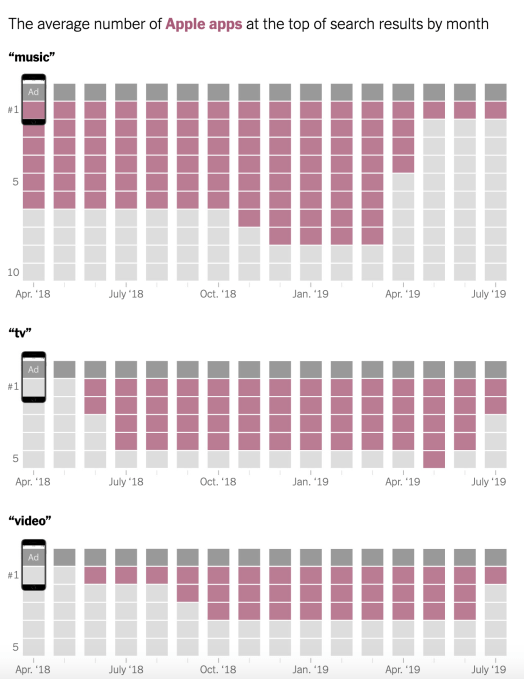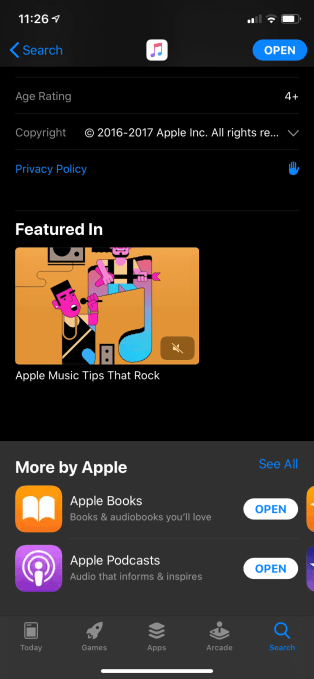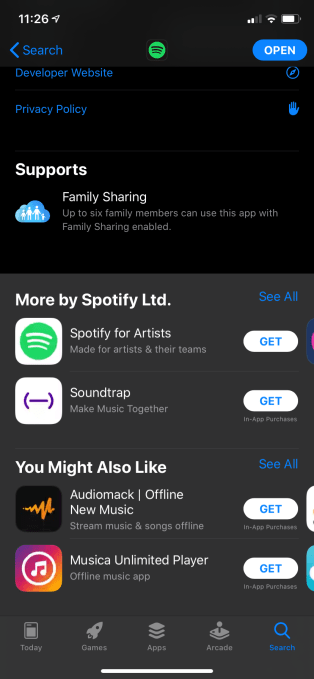That Apple has used its App Store to offer itself a competitive advantage is nothing new. TechCrunch and others have been reporting on this problem for years, including those times when Apple chose to display its apps in the No. 1 position on the Top Charts, for example, or when it stole some of the App Store’s best ideas for its own, banned apps that competed with iOS features, or positioned its apps higher than competitors in search. Now, in the wake of antitrust investigations in the U.S. and abroad as well as various anticompetitive lawsuits, Apple has adjusted the App Store’s algorithm so fewer of its own apps would appear at the top of the search results.
The change was reported by The New York Times on Monday, who presented Apple with a lengthy analysis of app rankings.
It even found that some searches for various terms would display as many as 14 Apple-owned apps before showing any results from rivals. Competitors could only rank higher if they paid for an App Store search ad, the report noted.
That’s a bad look for Apple which has recently been trying to distance itself and its App Store from any anti-competitive accusations.
In May, for example, Apple launched a new App Store website designed to demonstrate how it welcomes competition from third-party apps. The site showed that for every Apple built-in app, there were competitors available throughout the App Store.
But availability in the store and discoverability by consumers are two different things.
Apple admitted to The NYT that for over a year many common searches on the App Store would return Apple’s own apps, even when the Apple apps were less popular or relevant at times. The company explained the algorithm wasn’t manipulated to do so. For the most part, Apple said its own apps ranked higher because they’re more popular and because they come up in search results for many common terms. The company additionally said that one feature of the app’s algorithm would sometimes group apps by their maker, which gave Apple’s own apps better rankings than expected.

Above: via The NYT, the average number of Apple apps that returned at the top of the search results by month
Apple said it adjusted the algorithm in July to make it seem like Apple’s own apps weren’t receiving special treatment. According to the NYT, both Apple VP Philip Schiller, who oversees the App Store, and SVP Eddy Cue, who oversees many of Apple’s apps, confirmed that these changes have not fully fixed the problem.
The issue, as Apple explains it, is that its own apps are so popular that it had to tweak its algorithm to pretend they are not. Whether or not this is true can’t be independently verified, however, as Apple doesn’t allow any visibility into metrics like searches, downloads, or active users.
Maybe it’s time for Apple’s apps to exit the App Store?
The report, along with the supposed ineffectiveness of the algorithm’s changes, begs the question as to whether Apple’s apps should show up in the App Store’s charts and search results at all, and if so, how.
To be fair, this is a question that’s not limited to Apple. Google today is facing the same problem. Recently, the CEO of a popular software program, Basecamp, called Google’s paid search ads a “shakedown,” arguing that the only way his otherwise No. 1 search result can rank at the top of the search results page is to buy an ad. Meanwhile, his competitors can do so — even using his brand name as the keyword to bid against.
The same holds true for the App Store, but on a smaller scale than the entirety of the web. That also makes Apple’s problem easier to solve.
For example, Apple could simply choose to offer a dedicated section for its own software downloads, and leave the App Store as the home for third-party software alone.
This sort of change could help to eliminate concerns over Apple’s anti-competitive behavior in the search results and chart rankings. Apple might balk against this solution, saying that users should have an easy way to locate and download its own apps, and the App Store is the place to do that. But the actual marketplace itself could be left to the third-party software while the larger App Store app — which today includes a variety of app-related content including app reviews, interviews with developers, app tips, and a subscription gaming service, Apple Arcade — could still be used to showcase Apple-produced software.
It could just do so outside the actual marketplace.
Here’s how this could work. If users wanted to re-install an Apple app they had deleted or download one that didn’t come pre-installed on their device, they could be directed to a special Apple software download page. Pointers to this page could be in the App Store app itself as well as in the iOS Settings.
An ideal spot for this section could even be on the existing Search page of the App Store.
With a redesign, Apple could offer a modified search screen where users could optionally check a box to return a list of apps results that would come only from Apple. This would indicate intentional behavior on the consumer’s part. That is, they are directly seeking an Apple software download — as opposed to the current situation where a user searches for “Music” and sees Apple’s own music app appear above all the others from rivals, like Spotify and Pandora.
Alternately, Apple could just list its own apps on this page or offer a link to this dedicated page from the search screen.
And these are just a few variations on a single idea. There are plenty of other ways the App Store could be adjusted to be less anti-competitive, too.
As another example, Apple could also include the “You Might Also Like” section in its own apps’ App Store listings, as it does for all third-party apps.
 Above: Apple Music’s App Store Listing
Above: Apple Music’s App Store Listing
This section directs users to other apps that match the same search query right within the app’s detail page. Apple’s own apps, however, only include a “More by Apple” section. That means its keeping all the search traffic and consumer interest for itself.

Above: Spotify’s App Store Listing
Or it could reduce the screen space dedicated to its own apps in the search results — even if they rank higher — in order to give more attention to apps from competitors while still being able to cater to users who were truly in search of Apple’s software.
But ultimately, how Apple will have to behave with regard to its App Store may be left to the regulators to decide, given Apple’s failure to bake this sort of anti-competitive thinking into its App Store design.













0 comments
Post a Comment